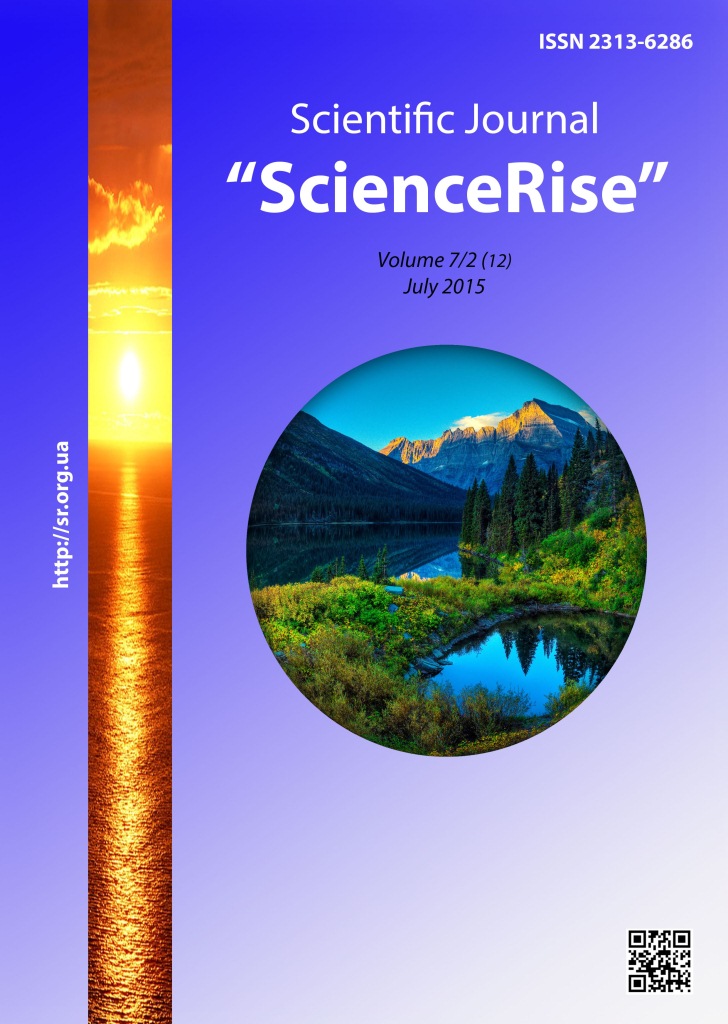Methods of determining the stability of geosystems in zones of NPP influence
DOI:
https://doi.org/10.15587/2313-8416.2015.47203Keywords:
geoecosystem stability, system failure, sustainability indicators, self-regulation, inertness, renewability, plasticity, environmental riskAbstract
This paper presents a mathematical apparatus and methodology of tasks research in assessing the sustainability of geological and ecological systems in the areas of NPP. The known methods for the determination of indicators of internal self-regulation geoecosystems as inertness, renewability and plasticity are considered. In the article a schematic diagram of obtaining integrated information on risk assessment for the territory of the state of environmental and human health is given. The analysis of the components of the environmental risk assessment is done
References
Popov, O. O. (2013). Pidhody do organizacii' ta vedennja kompleksnogo radioekologichnogo monitoryngu nazemnyh ekosystem u rajonah roztashuvannja AES [Approaches to the organization and conducting of comprehensive radiological monitoring of terrestrial ecosystems in the areas of nuclear power plants influence]. Zbirnyk naukovyh prac' IPME im. G.Je. Puhova NAN Ukrai'ny, 68, 11–18.
Jacyshyn, A. V., Popov, O. O., Artemchuk, V. O. (2014). Metody vymirjuvannja parametriv navkolyshn'ogo pryrodnogo seredovyshha [Measurement methods of environmental parameters]. Visnyk Nacional'nogo tehnichnogo universytetu "HPI". Serija: Mehaniko-tehnologichni systemy ta kompleksy, 40(1083), 130‑137.
Allesina, S., & Tang, S. (2012). Stability criteria for complex ecosystems. Nature, 483(7388), 205–208. doi: 10.1038/nature10832
Fowler, M. S., Laakso, J., Kaitala, V., Ruokolainen, L., & Ranta, E. (2012). Species dynamics alter community diversity-biomass stability relationships. Ecol Lett, 15(12), 1387–1396. doi: 10.1111/j.1461-0248.2012.01862.x
Kostyshyn, S. S., Rudenko, S. S. (2012). Innovacijni tehnologii' ocinky stijkosti vydiv ta ecosystem [Innovative technologies assessing the sustainability of species and ecosystems]. Ekologichni nauky, 1, 91‑102.
Kolomyc, Je. G., Sharaja, L. S. (2014). Ustojchivost' lesnyh jekosistem, metody ee ischislenija i kartografirovanija [Sustainability of forest ecosystems, methods of its calculation and mapping]. Izvestija Samarskogo nauchnogo centra Rossijskoj akademii nauk, 16 (1‑1), 93‑107.
Havanskaja, N. M. (2011). Metodicheskie podhody k ocenke ustojchivosti geosistem k vozdejstviju dobyvajushhej promyshlennosti [Methodical approaches to the estimation of stability of geosystems exposed to the mining industry]. Vestnik Volgogradskogo gosudarstvennogo universiteta. Serija 3: Jekonomika. Jekologija, 3 (1), 254‑257.
Loreau, M., & de Mazancourt, C. (2013). Biodiversity and ecosystem stability: a synthesis of underlying mechanisms. Ecol Lett, 16, 106–115. doi: 10.1111/ele.12073
Moiseenko, T. I., Gashev, S. N. (2011). Mehanizmy ustojchivosti i izmenchivosti jekosistem v uslovijah ih zagrjaznenija [Mechanisms of resistance and variability of ecosystems under the conditions of their pollution]. Vestnik Tjumenskogo gosudarstvennogo universiteta, 12, 17‑27.
Badanova, U. A., Savvateeva, O. A. (2014). Ispol'zovanie sistem komp'juternoj obrabotki prostranstvennoj informacii – osnova ocenki ustojchivosti jekosistem urbanizirovannyh territorij [Usage of computer processing of spatial information ‑ the basis of assessment of the sustainability of ecosystems of urbanized areas]. Uspehi sovremennogo estestvoznanija, 8, 87‑88.
Avtonomov, A. N. (2014). K voprosu ustojchivosti sklonovyh jekologicheskih sistem jekzogennogo tipa [On the problem of stability of slope environmental systems exogenous type]. Fundamental'nye issledovanija, 9‑10, 2181‑2185.
Marova, S. F., Buryh, Ju. V. (2014). Analiz metodychnyh pidhodiv do ocinjuvannja stijkosti ekologo-ekonomichnyh system [Analysis of methodological approaches to the evaluation of ecological sustainability and economic systems]. Teoretychni i praktychni aspekty ekonomiky ta intelektual'noi' vlasnosti, 1(1), 370‑376.
Aleksandrovskaja, L. N., Aronov, I. Z., Kruglov, V. I. (2008). Bezopasnost' i nadezhnost' tehnicheskih system [Safety and reliability of technical systems]. Moscow: Universitetskaja kniga, Logos, 376.
Vetoshkin, A. G. (2003). Nadezhnost' tehnicheskih sistem i tehnogennyj risk [Reliability of technical systems and technogenic risk]. Penza: Izd-vo Penz. gos.un-ta, 155.
Semenov, A. A., Melkumjan, V. G. (1998). Osnovy teorii' nadijnosti [The course of reliability theory]. Kyi'v: KMUCA, 84.
Henli, Je. Dzh., Kumamoto, H. (1984). Nadezhnost' tehnicheskih sistem i ocenka riska [Reliability of technical systems and risk assessment]. Moscow: Mashinostroenie, 528.
Lysychenko, G. V., Zabulonov, Ju. L., Hmil', G. A. (2008). Pryrodnyj, tehnogennyj ta ekologichnyj ryzyky: analiz, ocinka, upravlinnja [Natural, technogenic and ecological risks: analyses, assessment and management]. Kyi'v: Nauk. dumka, 542.
Popov, O. O. (2013). Metody analizu ryzykiv v ekologii' [Methods of risks analyses in ecology]. Zbirnyk naukovyh prac' IPME im. G.Je. Puhova NAN Ukrai'ny, 69, 19‑28.
Lysychenko, G. V., Hmil', G. A. Barbashev, S. V. (2011). Metodologija ocinjuvannja ekologichnyh ryzykiv [Methodology of assessment of ecological risks]. Odesa: Astroprynt, 368.
Jacishin, A. V., Kameneva, І. P., Popov, O. O., Artemchuk, V. O. (2012). Metody i tehnologii analiza riskov dlja zdorov'ja na osnove dannyh monitoringa [Methods and technologies of risk assessment on health of population based on monitoring data]. Materialy IV Mezhdunarodnoj nauchno-tehnicheskoj konferencii «MODELIROVANIE-2012», 469‑473.
Downloads
Published
Issue
Section
License
Copyright (c) 2015 Александр Александрович Попов, Валерия Емельяновна Ковач, Олег Викторович Бляшенко, Виктор Емельянович Ковач, Кирилл Владимирович Сметанин

This work is licensed under a Creative Commons Attribution 4.0 International License.
Our journal abides by the Creative Commons CC BY copyright rights and permissions for open access journals.
Authors, who are published in this journal, agree to the following conditions:
1. The authors reserve the right to authorship of the work and pass the first publication right of this work to the journal under the terms of a Creative Commons CC BY, which allows others to freely distribute the published research with the obligatory reference to the authors of the original work and the first publication of the work in this journal.
2. The authors have the right to conclude separate supplement agreements that relate to non-exclusive work distribution in the form in which it has been published by the journal (for example, to upload the work to the online storage of the journal or publish it as part of a monograph), provided that the reference to the first publication of the work in this journal is included.

